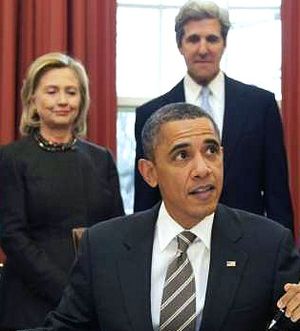The “Good News” of an Ideological Party
Note: We’re in the last few days of the year and there’s still time to donate to the work of The Catholic Thing. All you need to do is to click on the Donate button and choose one of the many easy ways to make your entirely tax-deductible contribution. Do it today. – Robert Royal
A distinction can be made between two kinds of political parties: pragmatic parties and ideological parties.
For most of its history the Democratic Party was a pragmatic party, not an ideological party. It was not interested in making a certain philosophy of life prevail in society. That’s what ideological parties do – for instance, the Communist Party in the old Soviet Union or the Nazi Party in Germany. They wish to transform society and culture so that a certain worldview prevails, a certain quasi-religion.
Pragmatic parties, by contrast, wish to distribute patronage to their friends, the patronage of jobs, contracts, tax breaks, and welfare benefits. They care little or nothing about ideology. To be sure, you will find ideologues and ideological elements in even the most pragmatic of pragmatic parties, just as you will find pragmatic elements in even the most ideological of ideological parties. But these ideological elements are minor elements in a pragmatic party, not major elements.
As noted, the Democratic Party throughout most of its history has been a pragmatic party; as have been its great rivals, the Republican Party and the earlier Whig Party.
But that is no longer true, and it grows less true with every passing year. The Democratic Party, I contend, is increasingly an ideological party, perhaps even predominantly an ideological party; and if it not yet predominantly ideological, it soon will be unless its current “progressive” trends are interrupted. In this regard, it resembles the Communist Party and Nazi Party.
Now I would not like to be misunderstood here. I am not suggesting that Democrats are like Nazis and Communists. Generally speaking, Democrats, even very ideological Democrats, are nice people. They are polite; they are often kind, sometimes very kind; they wouldn’t hurt a flea (notwithstanding the fact that they would cheerfully have unborn babies killed). But they are ideologues; or at least they are led by ideologues, and the rank and file follow these ideological leaders.
The great majority of Democrats, I concede, are not ideologues; it is not their intention to transform America’s traditional culture and replace it with a “new and improved” culture. But the Democratic Party is being led today by leftist ideologues who wish to do precisely that. These ideologues are the “brains” of the party, while everybody else provides the party’s “muscle.”
What do these intellectual leaders of the party believe? What is the new and improved culture they wish to persuade the American people to adopt? What is the “good news” they preach?
(1) They preach a metaphysics: There is no God, at least no God like the God of the Bible; no Supreme Being who created the universe and governs it. And if they sometimes say that they are agnostics, not atheists, their agnosticism is virtually identical with atheism; the two differ in name only.
(2) They preach a theory of knowledge: There is no knowledge other than sense-based knowledge, the kind of empirical knowledge upon which natural science is based. (They pride themselves on their respect for science even though very few of them are actual scientists or philosophers or historians of science.) Thus there is no such thing as Divine Revelation. And there is no such thing as trans-empirical intuitive knowledge – for example, intuitive knowledge of the existence of God, of the immortality of the soul, of the fundamental laws of morality.
(3) They preach a theory of morality, a morality of maximum personal liberty. We should be free to do as we like, and we should tolerate a like freedom in others. Of course certain practical limits must be placed on this freedom if we are to avoid a war of all against all: we should not be free to inflict direct and tangible harm on non-consenting others.
(4) Sexual freedom: While there are many other kinds of freedom, sexual freedom is, so to speak, the keystone of the arch. If sexual intolerance is permitted, many other kinds of intolerance will follow.
(5) Anti-Christianity: The most influential opponent of the above beliefs and values is Christianity, more especially old-fashioned Catholic and Protestant Christianity. Therefore old-fashioned Christianity must be marginalized, must be driven into a social corner where it can do little or no harm.
(6) Omnicompetent government. There is no problem, not even the problem of controlling the terrestrial climate for the next 10,000 years, that cannot be solved, at least in the long run, by the action of the U.S. federal government. Do we have problems of poverty or crime or education or health or drug addiction or global warming? There must be solution that Washington can find for it – a law, an agency, a spending program, a global treaty, etc.
With regard to ideology, Democrats can be divided into three concentric circles. The innermost circle is made up of the leftist ideologues I’ve been talking about; they are the ones who manufacture “progressive” ideas and distribute them at the wholesale level.
The next circle, a larger circle, is made up of semi-ideologues; they are consumers and retail distributors of these ideas.
The outermost circle, the largest circle of all, is made up of non-ideologues. If they accept, or at least don’t oppose, “progressive” ideas, this is not from love of these ideas but from party loyalty. In this outermost circle can be found many blacks, Latinos, labor union members, and family heritage Democrats.
The Democratic Party isn’t the only crucial place where anti-Christian ideologues and semi-ideologues have won control. They have also won control in the entertainment industry, in the news media, and in our leading colleges and universities (including law schools).
A relatively small number of smart and well-organized fanatics can re-shape a culture. It’s happened many times in the past, and it’s now happening right under our noses.
© 2016 The Catholic Thing. All rights reserved. For reprint rights, write to: info@frinstitute.orgThe Catholic Thing is a forum for intelligent Catholic commentary. Opinions expressed by writers are solely their own.




